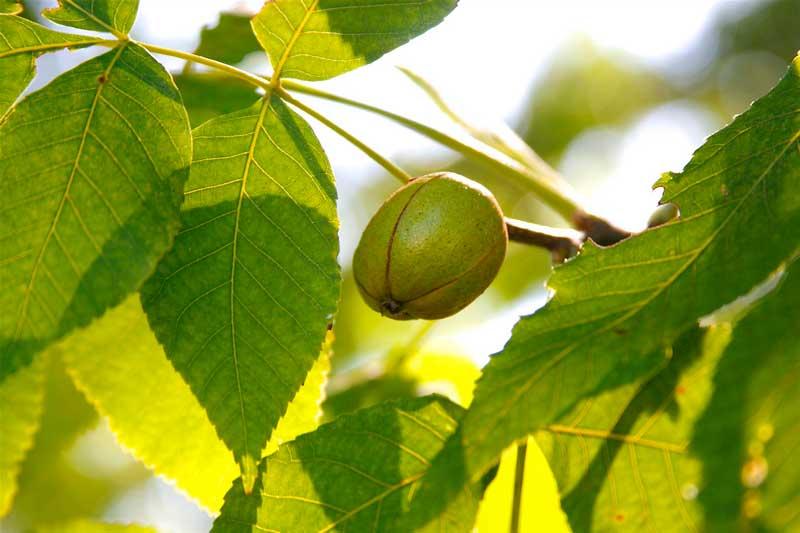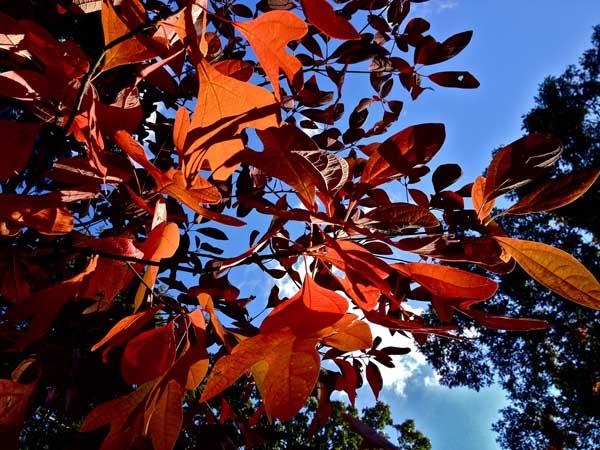Native Tree Picks
By Bridget Abernathy
We are well into fall, and the brilliant autumn color is gradually fading. Before entering the busy winter holiday season of shopping, cooking, and gathering with family and friends, we may spend time raking the last of the fallen leaves, stacking firewood, and getting ready to spend more time indoors. Despite the cooling weather, the late fall and early winter season is an excellent time to plant trees.
Many local nurseries have fall sales, and as long as the trees have been well cared for in the nursery, you can find high-quality, larger nursery stock trees at a significant discount. Selecting the right native species for your site is essential for the long-term health and survival of your tree.
I have picked a few of my favorite native species that grow well in Central Kentucky:
Shellbark Hickory - Carya laciniosa

(Link to fact sheet from University of Kentucky Horticulture Extension)
Shellbark hickory’s broad yellowish-rust foliage, large edible nuts, straight trunk, and thick shaggy bark make this tree a unique feature in the landscape. This tree prefers deep, fertile, moist bottomlands, although it can less commonly occur on drier sandy soils and open cedar glades. Shellbark hickory thrives in full sun, and requires ample growing space for its broad crown. Its leaves are dark green and pinnately compound, with usually seven finely-toothed leaflets. Leaves turn yellow, rust, or golden brown in autumn, and typically fall in October. Also called kingnut, shellbark hickory boasts the largest of all hickory nuts. Each oblong nut is encased in a thick husk, which splits open in the early fall when it ripens. The sweet nuts are edible to humans and are also consumed by mice, chipmunks, squirrels, raccoons, foxes, deer, ducks, and wild turkeys. This tree has no serious disease or insect problems that affect its development, but it can be susceptible to pecan weevil, hickory bark beetle, and twig girdler. Shellbark hickory is relatively long-lived and slow growing, but its strong branches will reward patient planters with its ability to withstand wind and ice storms. Shellbark hickory can reach a height of 60-80 feet on most sites.
Sassafras - Sassafras albidum

(Link to fact sheet from University of Kentucky Horticulture Extension)
Sassafras’ brilliant fall foliage, distinct branch architecture, deeply furrowed bark, and persistent fruit make this tree exceptional for all seasons. This moderately fast-growing, aromatic tree grows well in slightly acidic, moist, well-drained loamy soil in full sun or part shade, but can also tolerate dry, sandy soils. Its leaves have three distinctive shapes: oval, mitten-shaped, and three-lobed, and are bright green in the summer and yellow, orange, red, and purple in the fall. Sassafras trees are dioecious (separate male and female trees). Small, greenish-yellow, fragrant flowers appear in the early spring, and give way to clusters of bluish-black berries that mature in September. The fruits are readily eaten by various species of birds, and squirrels, rabbits, beaver, and bears eat the fruit, bark, and wood. A variety of insect and disease problems can affect sassafras, but they are usually not a major concern. Japanese beetles, sassafras weevils, promethea moths, and scales can be found on this tree, and diseases such as leaf spots, cankers, mildews, wilts, and root rots can also develop. This tree is easy to grow and generally requires little care. Sassafras can reach a height of 30-60 feet.
Witch-hazel - Hamamelis virginiana

(Link to fact sheet from University of Kentucky Horticulture Extension)
Witch-hazel’s attractive yellow autumn foliage, multi-stemmed arching branches, fragrant and distinctive fall-blooming flowers, and persistent woody fruit offer year-round interest in the garden or yard. This large shrub or small tree grows best in rich, moist, slightly acidic or neutral well-drained silty loam, but can tolerate heavy clay soils and a variety of moisture conditions. Witch-hazel will grow at a slow to medium rate in full sun or partial shade; however, prolific flower development requires full sun. The leaves are alternate, simple, and oval-shaped, with large wavy-toothed margins and a distinctly asymmetrical leaf base. Dark green foliage turns gold to yellowish-orange in the fall. Witch-hazel has an extraordinary flower pattern. The fragrant, creamy to bright yellow flowers have slender, ribbon-like petals, and appear from late October to December. Although pollination takes place in the fall, fertilization does not occur until the following spring. Seeds develop inside a woody capsule, and are forcibly ejected 20-30 feet away when mature. This ejection has a distinct “snapping” sound, which has led to the plant’s other common name, snapping hazel. Occasionally, cone gall aphids or spiny leaf gall aphids can cause galls to form on leaves, and powdery mildew may also be found on leaves. These are generally not significant problems. Witch-hazel is typically multi-trunked, and usually grows to a height of 10-15 feet.
Photography
- Shellbark hickory (Dan Mullen)
- Sassafras (Fritz Flohr Reynolds)
- Witch-hazel (Jessie Hirsch)
About the Author
Bridget Abernathy is the Assistant Director of Urban Forestry for the Kentucky Division of Forestry. Email at bridget.abernathy@ky.gov
